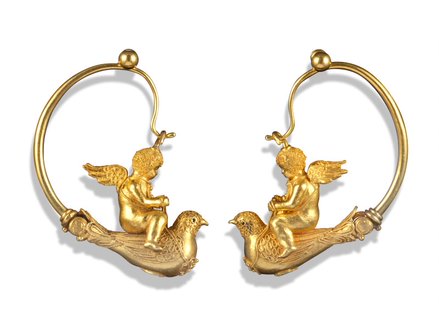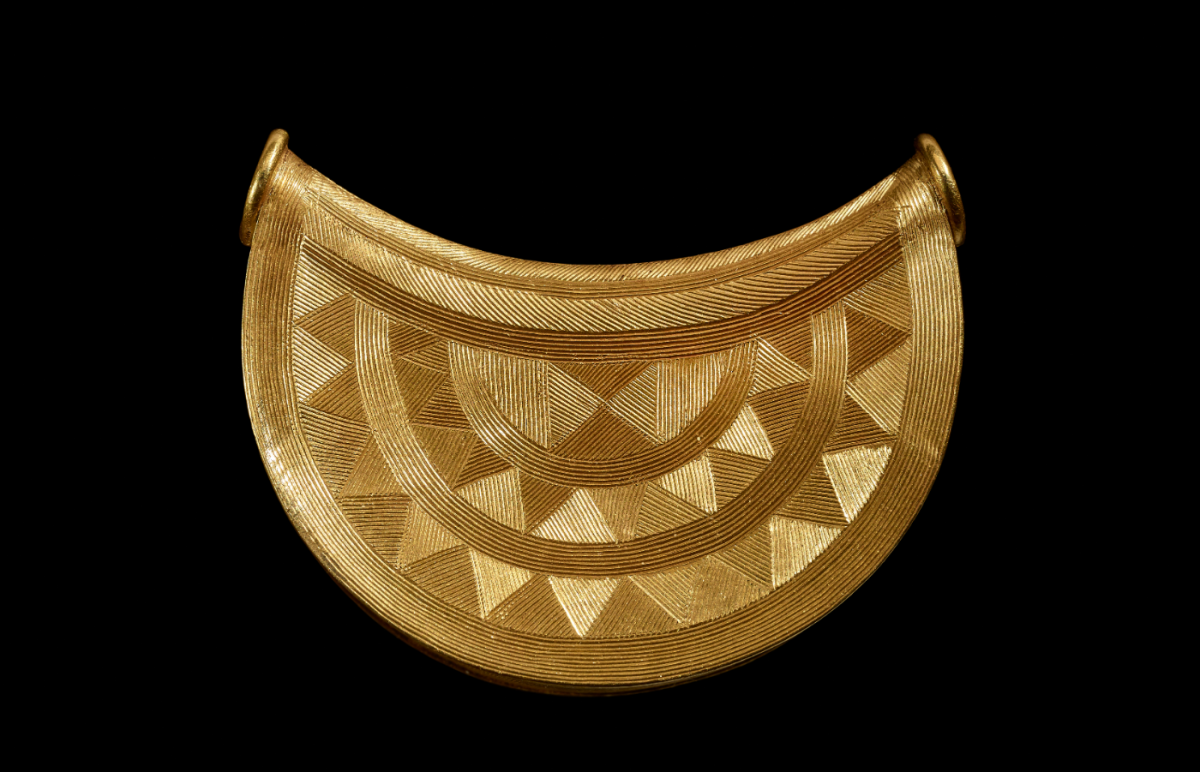This wonderful Cornish workshop and museum is dedicated to the legacy of studio pottery trailblazer Bernard Leach
Become an instant expert on reading the past through the medium of jewellery
Become an instant expert on reading the past through the medium of jewellery
17 May 2022
Portable, practical, timeless and durable: the importance of the role of jewellery in tracking the progress of civilisation cannot be overestimated, says our expert John Benjamin. Mirroring changes in social and economic custom and behaviour, its sheer indestructibility has meant that, whether a simple gold ring or opulent tiara, jewellery has long acted as a lightning conductor to the past
 A pair of gold Etruscan Revival earrings attributed to Melillo, c.1870, depicting putti riding doves
A pair of gold Etruscan Revival earrings attributed to Melillo, c.1870, depicting putti riding doves
 A Bronze Age sun pendant, 1000–800BC, to be seen in the British Museum’s exhibition The World of Stonehenge until 17 July
A Bronze Age sun pendant, 1000–800BC, to be seen in the British Museum’s exhibition The World of Stonehenge until 17 July
1. FROM EARLY TIMES...
We know that as far back as the Neolithic Age humans were able to differentiate between types of coloured stone, attributing them with restorative, magical and supernatural powers.
Jet-black obsidian, for example, was crushed into powder and swallowed, as it was thought to have medicinal, healing values, while in China jade has been endowed with mystical properties for thousands of years.
The ancient Egyptians produced amuletic jewels inspired by animals, birds (such as the falcon) and insects – most notably the scarab beetle, which was thought to be a powerful symbol of resurrection and the afterlife. It was said that the soul of the sun god Ra was incorporated into the body of the beetle.
Finds such as the Sutton Hoo treasure and the Staffordshire Hoard of Anglo-Saxon gold and silver metalwork have led to a complete reappraisal of our understanding of the way people of rank and authority lived in the so-called Dark Ages. Pieces from these collections display a breathtaking artistry, not only in their intricate design and sophisticated construction, but also in the deft use of gemstones – such as garnets – in complex cloisonné settings.
From such ancient hoards, we move to the later Gothic period, which broadly extends from 1200 to 1500.
Goldsmiths had begun to establish themselves in European towns and cities, producing jewellery and ornaments in which the design was heavily influenced by church architecture and symbolism. Gems such as sapphires and rubies were cut into fairly rudimentary, polished domes known as cabochons, often set in gold ring mounts bearing religious inscriptions. Enamel became an important and versatile decorative component for jewellery, especially basse-taille (an enamelling technique), in which thicknesses of translucent enamel covered large surfaces of metal.
 A 17th-century table-cut diamond and gold cruciform pendant
A 17th-century table-cut diamond and gold cruciform pendant
2. PRECIOUS GEMS
In the 16th century gems such as emerald, ruby and sapphire began to be brought into Europe from exotic locations, among them Colombia, India and Asia, along newly established trade routes.
Pearls also became the versatile gem of choice, drilled and threaded into long rope necklaces, set as a decorative accompaniment in hair ornaments known as biliments or, frequently, as the central component in colourful, enamelled gold pendants.
Sometimes these pearls were distorted in shape – known as baroque pearls – and their sheer individuality allowed the goldsmith scope to create fantastically imaginative designs inspired by birds, sea monsters and wild animals.
From here we move to the 17th century, the time when Huguenots had begun to settle and prosper in cities in the Low Countries, including Amsterdam and Antwerp. Guilds and workshops were established in which new diamond-cutting techniques were put into practice, coaxing out the sparkle from the stone, as seen in the cruciform pendant shown here. Until this time the majority of diamonds in Continental jewellery had tended to appear grey and lifeless. In fashionable society it became more common for women to wear formal diamond jewels such as breast ornaments, stomachers, hair ornaments known as aigrettes and elaborate Sévigné bow brooches, named after the celebrated French aristocrat Madame de Sévigné.
By the 18th century the diamond had truly become the gemstone of choice.
Members of the aristocracy and the nouveau riche socialised at grand balls and dances with lit candles in chandeliers and wall sconces; these set off the twinkling beauty of diamond jewels to perfection. On the downside, this new-found desire for diamonds also led to a remorseless growth in jewellery theft and forgery.
 A George III gold and multi-gem set parure, mounted in a medley of gemstones popular in the 18th century, including amethyst, pink topaz, golden topaz and emeralds
A George III gold and multi-gem set parure, mounted in a medley of gemstones popular in the 18th century, including amethyst, pink topaz, golden topaz and emeralds
3. POWERFUL INFLUENCES
Towards the end of the 18th century fashion started to dictate a new direction.
The elaborate and overcomplicated Baroque and Rococo jewels of the 1750s began to be replaced with pieces that were infinitely more subtle and understated, evoking the styles and fashion of classical antiquity.
Napoleon was largely instrumental in this new passion for the look of ancient Rome and Pompeii, since many treasures were brought back to Paris following his campaigns in Italy and Egypt.
Similarly, young aristocrats on the so-called grand tour habitually returned to Britain with artefacts purchased in Rome, Florence and Venice. Cameos and intaglios became universally popular, as did jewels that conveyed messages of intimacy. This was the era of the ‘language of flowers’ and jewelled padlocks, brooches with hidden lockets and elegant little gold rings, set with half pearls and pretty gems such as ruby and turquoise, which were all the perfect vehicle for conveying love and affection.
As the 19th century progressed, sentimental and romantic jewels were superseded by designs inspired by nature and naturalism. Brooches, for example, were fashioned as bouquets of flowers, insects and birds, ears of corn and leaf sprays. Diamonds, previously fully set in silver, began to be set in gold, their mounts opened at the back to allow as much light as possible to pass through.
By the 1850s and 60s expansion in the tourist industry led to people in Britain visiting France and Italy for pleasure, resulting once again in a renewed interest in classical and archaeological forms known as Classical Revivalism.
Brilliant craftsmen such as Fortunato Pio Castellani in Rome and Carlo Giuliano in London captured the mood perfectly, creating technically superb jewels evoking the beauty of ancient torcs, fibulas and diadems. This revivalism was very much a Victorian phenomenon, with the repetition of Gothic, medieval, Renaissance and Neoclassical themes in 19th-century jewellery design lasting right up to the end of the century.
The final 20 years of that century saw an explosion in jewellery production across Europe, resulting in an inevitable decline in individuality and quality.
In Britain the mass production of jewellery was centred in Birmingham, with hundreds of workshops churning out what some might consider rather unimaginative jewels – bangles, rings, brooches and necklaces – fashioned in nine-carat gold, silver and gilt metal. This trend was to continue through the Edwardian era, where elegant diamond jewellery was to compete with cheap and cheerful bijouterie in jewellery shop windows.
 An Arts and Crafts cabochon moonstone and enamel pendant by Archibald Knox, known for his collaboration with Liberty. Moonstone was one of the most frequently used stones of this period
An Arts and Crafts cabochon moonstone and enamel pendant by Archibald Knox, known for his collaboration with Liberty. Moonstone was one of the most frequently used stones of this period
4. PLATINUM... AND BEYOND
The most significant development in 20th-century jewellery construction had nothing to do with an influential artistic movement, but with the introduction of a revolutionary new metal – platinum.
For the first time diamonds and gems could be mounted in strong but elegant settings that enhanced, rather than hindered, the appearance of the stones themselves. Platinum underscored the success of jewellery manufacturers that are household names today, such as Boucheron, Van Cleef & Arpels, Tiffany and Cartier. Its importance can never be overstated.
The changing face of jewellery design from 1900 onwards was fast-moving and dynamic.
In Edwardian Britain, firms such as Liberty and Child & Child sold pretty Arts and Crafts pendants inspired by nature, while in Paris and Brussels the Art Nouveau creations of visionary craftsmen such as Philippe Wolfers and René Lalique possessed a dreamlike sophistication of incomparable technical virtuosity.
By the 1920s, however, all this instinctive naturalism faded away in the drive for jewellery that was bold, colourful and geometric in its construction – in the style of Art Deco. Gems such as rubies, sapphires and emeralds were cut into perfect symmetrical shapes, set in architectural-style diamond frames. Today these jewels are as popular as they were in the 1920s and 30s.
Then came the war years.
These not only changed the look of jewellery, but also the availability of precious metals, especially platinum. In the 1940s and 50s gold ‘retro’ jewellery became popular, often mounted with large semi-precious stones including aquamarine, tourmaline and amethyst.
The 1960s and 70s saw the development of daring experimental designer jewellery by craftsmen still celebrated today, including Andrew Grima, Wendy Ramshaw and John Donald.
From the 1980s onwards, jewellery has truly become a global discipline where household names – Cartier, Graff and Harry Winston – sell magnificent, fancy, colour diamonds and priceless gems to a highly sophisticated and well-informed international clientele. Jewellery has come a long way since the days of powdered obsidian and scarabs.
 A synthetic sapphire and diamond ring, which dates to the 1920s, when synthetic rubies and sapphires had begun to be set, often in expensive diamond jewellery. These early synthetic stones can exhibit telltale internal characteristics such as tiny air bubbles and curved growth lines
A synthetic sapphire and diamond ring, which dates to the 1920s, when synthetic rubies and sapphires had begun to be set, often in expensive diamond jewellery. These early synthetic stones can exhibit telltale internal characteristics such as tiny air bubbles and curved growth lines
5. KNOW YOUR GEMMOLOGY
Whatever the period, anyone wishing to embark upon a serious career in the jewellery industry will have needed to learn about gemmology – the science, analysis and identification of gems.
It's all very well being able to recognise that a red stone is probably a ruby, but what type of ruby is it? Is it a rare old specimen from the ancient mines in Burma (and thus worth an absolute fortune) or is it a modern Far Eastern stone that has been subjected to artificial treatments, such as glass-filling or heating, to improve its appearance? Is it indeed a ruby at all, or might it be an inexpensive garnet, a rare spinel or even faceted glass?
Understanding gemmology is key to identifying the technical content of a piece of jewellery and may even be helpful in dating the item. For example, pale greenish-blue aquamarine was a popular stone in the era of George IV and William IV, while deep-blue Brazilian aquamarines are almost all a 20th-century phenomenon.
More than anything else jewellery is, and has always been, all about the money.
A dealer who knows how to calculate the weight of a mounted gemstone; who can tell where it originated; and who can identify its internal and external characteristics will be one step ahead of competitors and be able to calculate and make a profit margin. Just as importantly, that dealer will know what to avoid, recognising, for example, that a diamond may have been lasered to improve its clarity, or an emerald treated to enhance its colour.
Today much of the jewellery that appears on the open market is sold at international auction and the gemmological attributes of individual stones are clearly set out by the saleroom selling the goods. Nevertheless, in spite of the torrent of information available at the click of a button, a basic understanding of the science of gems will always be an invaluable tool for dealers and collectors.
JOHN'S TOP TIPS
Places to go
If you’re seeking jewellery to buy, attend auction house viewing days if you can, and invest in a decent 10x jeweller's magnifier lens.
While every auction house will incorporate sections of jewellery in their monthly or quarterly sales, there are a number of salerooms that not only hold excellent, in-depth stand-alone jewellery sales, but are also helpful to new buyers. Among some to note are Bonhams in Knightsbridge, Woolley and Wallis in Salisbury, Sworders in Stansted Mountfitchet, Fellows in Birmingham and Tennants in Leyburn.
One venue I would urge anyone interested in antique jewellery to visit is the incomparable William and Judith Bollinger Gallery of jewellery at the Victoria and Albert Museum.
Good reads
- My own Starting to Collect Antique Jewellery (Antique Collectors Club) is a good entry-level book for beginners, or for those seeking to extend their knowledge on specialised topics as diverse as mosaics, cameos, arts and crafts and Fabergé
- Understanding Jewellery by David Bennett and Daniela Mascetti (Antique Collectors Club) has recently been reprinted and is regarded as the standard work on the subject
-
Jewels & Jewellery by Clare Phillips (Victoria and Albert Museum) illustrates many items in the V&A's own collection
About the Author

John Benjamin
John is a former international director of jewellery at Phillips fine art auctioneers and established his own independent jewellery valuation and advisory service in 1999. A freeman of The Goldsmiths' Company and a founder liveryman and court assistant of The Worshipful Company of Arts Scholars, he has been a speaker for The Arts Society for over 20 years. He is a regular contributor to the BBC’s Antiques Roadshow and in 2021 was appointed honorary jewellery adviser to the National Trust. Among his talks for The Arts Society are A History of Jewellery from Elizabeth I to Elizabeth Taylor, The life and work of Peter Carl Fabergé: the world's greatest goldsmith, and At the sign of the falcon: the extraordinary life and work of Henry George Murphy (the Jazz Age goldsmith).
Article Tags
JOIN OUR MAILING LIST
Become an instant expert!
Find out more about the arts by becoming a Supporter of The Arts Society.
For just £20 a year you will receive invitations to exclusive member events and courses, special offers and concessions, our regular newsletter and our beautiful arts magazine, full of news, views, events and artist profiles.
FIND YOUR NEAREST SOCIETY
MORE FEATURES
Ever wanted to write a crime novel? As Britain’s annual crime writing festival opens, we uncover some top leads
It’s just 10 days until the Summer Olympic Games open in Paris. To mark the moment, Simon Inglis reveals how art and design play a key part in this, the world’s most spectacular multi-sport competition



